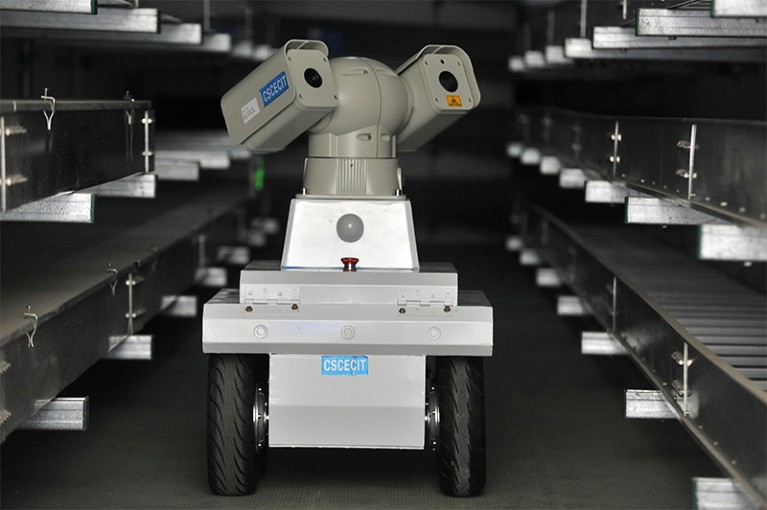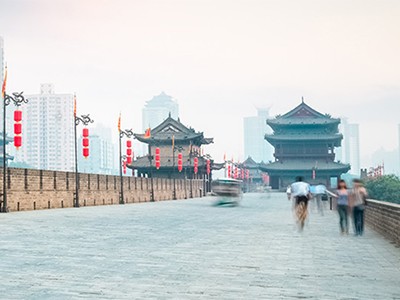When Chen Chen received word from a business incubator in Xi’an, in central China, offering to house and fund his fledgling company, the high-tech entrepreneur thought it might be a scam. He’d spent months looking for a low-cost site where he could manufacture highly efficient semiconductors for use in LEDs and lasers, and here was an empty, yet fully operational, semiconductor factory filled with equipment and people that could make his dream a reality. The message had come over the social media platform WeChat, from an investment manager working at the incubator.
Chen’s invitation was the indirect result of national policies designed to bring growth to Xi’an, the capital of Shaanxi province, one of China’s poorer, inland regions. In 2013, the central government had announced an ambitious vision called the Belt and Road Initiative (BRI) that would put Xi’an back at the centre of a massive trade network linking China with her landlocked neighbours to the west, as well as with a host of other nations across the three continents of Europe, Africa and Asia. The news sparked a surge of activity in local government, including a commitment to transform the city into an innovation-driven hub by 2019.
“Who would spend millions of renminbi to turn a factory into an incubator hub? Just maintaining that kind of site would be very costly,” says Chen, a graduate of Tsinghua University, Beijing, who grew up in Shandong province in northern China, before moving to the United States in 2006. “I thought it was too good to be true.”
Yet in January 2017, when Chen flew from his home in New Haven, Connecticut, the mechanical engineer found an optoelectronics incubator called the OEIC that was offering exactly what the investment manager had promised. Chen had what he needed to develop his business — and start making semiconductors.
Opened in 2016 by Xi’an’s Institute of Optics and Precision Mechanics, the OEIC is a former manufacturing site that houses 20 start-ups developing computer chips for everything from high-end sensors to semiconductor lasers. It is the direct product of Xi’an’s academic and political leaders, who hope to create a high-tech ecosystem where university researchers and private sector start-ups work side by side, echoing the model of Silicon Valley.
The site is one ambitious example of Xi’an’s plans for economic growth. The city was once the most important in China, situated at the start of the Silk Road trading route, an ancient arterial network that carried Asian goods and spices to the Mediterranean and brought back European wares. Since China reopened its doors to world trade in 1978, the landlocked former capital has been overshadowed by seafaring coastal economies to the east, such as the more globalized cities of Shanghai and Beijing.
Expanding fast
The BRI is an economic action plan to strengthen trading and cultural relationships between China and countries in Asia, Africa and Europe. It has become increasingly hard to define, according to Dirk van der Kley, who is based in Sydney and researches Chinese foreign policy at the Australian National University in Canberra. “There is a real sense of mission creep,” he says. “Infrastructure funding and investment in enterprise are being used to further the Chinese Communist Party’s agenda to increase the country’s social and cultural influence in these regions.”
In Xi’an, the government is offering financial incentives for companies to start businesses in countries associated with the BRI.
“Thanks to investment from China, the intercity roads in Kyrgyzstan are often as good as in Australia between cities,” says Van der Kley. “But there are the downsides. Some countries have taken on huge debts. Many Chinese companies, particularly inexperienced ones, run into trouble. They struggle with local culture and politics. Local hiring is also tricky. It varies by company and country. Initially, many companies do not hire many locals. But if they stay for a long period, companies do tend to localize their workforce.”
Aside from that, levels of Chinese investment in BRI projects have been exaggerated, according to research by the Berlin-based Mercator Institute for China Studies (MERICS)’.
“Investors and commercial banks are aware of the difficulties of investing in some of the countries along the Belt and Road. In 2017, Chinese firms invested just US$14 billion across 70 countries, which is pretty small fry,” says Van der Kley. “If you look in most parts of southeast Asia for example, China is not the leading investor. It’s the US or Japan. In some cases Singapore, which is a re-routing point for Chinese investment in southeast Asia, is the leading investor. But even so, China is not as dominant as is sometimes portrayed.”
Yet Xi’an’s leaders remain optimistic. Fang Guanghua, deputy mayor of the Xi’an Municipal People’s Government, says that the city is “indisputably standing at the forefront of opening up to the West in a new era, since the launching of the Belt and Road Initiative.”

An intelligent robot patrols a project site in Xi’an.Credit: VCG via Getty Images
Rather than transporting silk across central Asia to the Mediterranean sea, the city’s officials are focused on expanding industries in the city that are competitive and driven by advanced science; these include the aerospace industry, and those dedicated to new materials, energy, artificial intelligence, and intelligent manufacturing systems that can operate with less human intervention. And that’s where the OEIC incubator comes in.
“I think it will take around five years for the city to establish itself as an innovative hub. Xi’an has the fundamentals, such as strong universities. New business is booming and lots of scientists are already coming to the city,” says Chen.
Xi’an is no stranger to advanced manufacturing, especially in aviation and military technology. Since 1949, when the People’s Republic of China was founded, the city has been a designated national base for the country’s military industry, thanks to its strategic location on the western edge of the heavily populated east-coast region. The city is home to companies that research weaponry, ships and nuclear technology; it also has 63 universities and 3,000 commercial, state and military-research units.
Despite its longstanding technological advantages, Xi’an has struggled to keep up with the rapid economic development of other cities. In 2016, Shaanxi province ranked 15th out of 32 provinces in terms of its gross regional product, according to China’s National Bureau of Statistics.
For a decade, Mi Lei, an engineer at Xi’an’s Institute of Optics and Precision Mechanics was frustrated by the lack of development. “No private investors were interested in advanced research projects like mine,” he says. “They preferred to invest in Internet companies that make money fast.”
In 2000, he began lobbying the city’s government for money to establish an ‘angel’ fund that would support the industrialization of what he calls hard-core technologies. These, he explains, are based on “research that needs long-term investment because it is difficult to be replicated or imitated, as it has an extremely high technical threshold”. As examples, he cites photoelectric chips, alternative forms of energy generation, intelligent manufacturing, information technology, life science and artificial intelligence, and new materials.
Before the city reached a decision, Lei decided to start investing himself, and one of his first bets was in Vivo Light. Run by a former colleague, the company makes machines that can identify the location of blood vessels with high levels of accuracy.
“In 2012, my daughter was given an injection, but the nurse failed several times to find the vein. I wanted to work with a team who could solve this problem. Now we’ve sold these machines to hospitals in China, South America and Japan,” says Lei, who was involved as a researcher at an early stage.
In 2013, Lei heard back from the government, which had decided to grant his wish, and set up CAS Star, an independently run incubator for start-ups; it’s funded by local municipal and education funding bodies.
Five years later, CAS Star has 260 full-time employees, up from 7; they include 45 investment staff and a 6-person legal team, as well as scientists and engineers who assist with research, and develop and acquire new lab equipment. The fund has already invested in more than 230 companies and received praise from China’s president Xi Jinping and premier Li Keqiang.
In 2016, Lei’s team joined with several government and university departments to set up the OEIC, where Chen has his team. Lei’s idea for hard-core technologies forms the core of the Xi’an government’s vision for its science and technology development — and his incubator is just one of multiple plans, such as the construction of a Xi’an Science Park and a Silk Road Science and Technology Centre, to seize the momentum offered by the BRI.
Li Xining, director of the Xi’an Municipal Science and Technology Bureau, says that Xi’an could catch up and even surpass other cities in China. However, he acknowledges that there will be challenges. “We need to break down ideological barriers that restrict innovation, and encourage people to aim for scientific breakthroughs,” he says. “We also need to promote the application of research and industrialization of innovation.” And he argues that scientists’ salary levels should be based on merit, rather than on the “irrational income distribution and defective incentive mechanisms” of the current system.
New recruits
Yuanyuan Ma, a nanoscientist who researches energy-efficient catalysts that can be used in treating water pollution, came to Xi’an after completing her PhD at the University of California, Davis. She has worked there for six years at a multidisciplinary research centre called Frontier Institute of Science and Technology. Ma says that despite the city’s large pool of universities, graduate talent regularly disappears because the government has not developed sustainable policies for creating high-quality jobs in research and development (R&D).
“It has concentrated on luring overseas talent with high salaries rather than promoting native talent. If a city cannot provide a positive platform for people’s talents, they won’t stay,” she says. “I do think things are changing now, though.”
In 2017, under the leadership of Wang Yongkang, Xi’an’s newly appointed party secretary, the municipal government issued a series of policy initiatives. These rubber-stamped the city’s rebranding as a Silk Road science-and-technology centre and approved 23 new recruitment policies, with a funding pledge of 3.8 billion yuan ($600 million), designed to attract 1,000,000 graduates to the city within the next 5 years — the majority of whom will be Chinese and already living in China.
“If you want to settle down in Xi’an, you may submit an application on your smartphone within 30 minutes to register as a resident,” says Fang about one of the new policies launched in March, which makes it much easier to register as a citizen of Xi’an from elsewhere in China.
Cao Junji, director of the Institute of Earth Environment in Xi’an, says that a change in research trends is also making it easier to attract talent. Last year, Cao’s group finished building the world’s largest air purifier, and his work is increasingly attractive to students, he says.
“In the past, it was hard to attract talent to work in this area. Now, we have lots of young talent because caring about the environment matters to younger people. And we can offer high salaries, as solving China’s air pollution problem is a key political priority, so we have plenty of funding,” says Cao.
China lacks high-quality Earth-science courses, says Cao, and so he is obliged to send many of his undergraduate students to study in the United States. But he says that Xi’an is beginning to take an academic lead and forge partnerships with its historic Silk Road neighbours, as part of the BRI.
For example, in May this year, Cao’s institute hosted its first Belt and Road Climate Change Training Course. Its stated aims were to improve the research capabilities of young scholars, promote cooperation and strengthen technology in China, and in countries such as Thailand along the ‘Belt and Road’.
According to Fang, Xi’an is also active in starting businesses in central Asian countries, such as Kyrgyzstan. And Xining says that the presence of overseas firms in the city plays an important part in promoting the scientific and technological progress of the city. “It accelerates the overall upgrading of industry,” he says.
Many large international enterprises, such as Samsung Electronics, Bosch and Intel have already set up their R&D centres in Xi’an, and Li hopes to attract more. The city’s officials want it to become a global centre for cutting-edge technology by 2025, they announced in late 2017. Just a few months later, in January 2018, Internet giant Alibaba unveiled a plan to build its regional headquarters in the city.
“Tell me which companies we should ask to partner with us,” Li says with a smile. “International cooperation is an important part if a city wants to become an international metropolis, no matter whether it’s past history or the present.”



 Meet a materials scientist enjoying the rise of China’s research scene
Meet a materials scientist enjoying the rise of China’s research scene
 Career guide: China
Career guide: China
 Hong Kong builds a science-based future
Hong Kong builds a science-based future
 China’s Zhejiang province is open for science business
China’s Zhejiang province is open for science business






